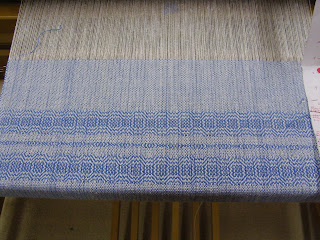 The first project was a set of six placemats that I started a while ago. I have a huge cone of fairly heavy cotton yarn that is dyed a varigated dark blue to white. I have used it a lot, and the cone still looks big. When our son Edwin told us he was getting married, I set to work finishing the placemats for Rebecca's bridal shower. Her favorite color is blue, so it was perfect for her.
The first project was a set of six placemats that I started a while ago. I have a huge cone of fairly heavy cotton yarn that is dyed a varigated dark blue to white. I have used it a lot, and the cone still looks big. When our son Edwin told us he was getting married, I set to work finishing the placemats for Rebecca's bridal shower. Her favorite color is blue, so it was perfect for her. The weft yarn was from my vast stash of fairly heavy cotton yarn that was given to me a couple years ago. Both yarns used in this project have been used many times for teaching children to weave. It's a great weight for making a project weave quickly, and still end up with something that is usable.
The weft yarn was from my vast stash of fairly heavy cotton yarn that was given to me a couple years ago. Both yarns used in this project have been used many times for teaching children to weave. It's a great weight for making a project weave quickly, and still end up with something that is usable. My eight year old grandson, Davey, spent a few days with Grandma after Thanksgiving Day. He had been doing some weaving on a rigid heddle loom, and was quite meticulous with his work, so I thought he was ready to move on to a four shaft loom.
My eight year old grandson, Davey, spent a few days with Grandma after Thanksgiving Day. He had been doing some weaving on a rigid heddle loom, and was quite meticulous with his work, so I thought he was ready to move on to a four shaft loom.  There was warp left over on the placemat loom, so we looked in the Davison book for a few choices for him. Since it was already threaded 1-2-3-4, he decided on a 2-2 twill that reverses direction with color changes. We decided that some white yarn and some different colors of green yarn that I had left over from another towel project would work well.
There was warp left over on the placemat loom, so we looked in the Davison book for a few choices for him. Since it was already threaded 1-2-3-4, he decided on a 2-2 twill that reverses direction with color changes. We decided that some white yarn and some different colors of green yarn that I had left over from another towel project would work well. I only got videos of him working on the four shaft table loom, but I did get a couple pictures of his work.
His selvedges look great and he is being pretty consistant with his beat. He was easily distracted though, so he only got a little bit done. Guess Grandma will have to have him over again soon!
 While Davey was weaving on his project, I finished up a rag throw rug made with wool fabric strips that a friend gave me. It was a design as I go type rug, with the stripe width being determined by the amount of a particular fabric. There were several different plaids and a few plain fabrics. I decided to seperate the different plaids with plain strips. To add a little interest to the plain fabric area, I twisted two colors together. That was ok for a couple rows at a time, but I wouldn't want to do a whole rug like that because the twisting takes too long.
While Davey was weaving on his project, I finished up a rag throw rug made with wool fabric strips that a friend gave me. It was a design as I go type rug, with the stripe width being determined by the amount of a particular fabric. There were several different plaids and a few plain fabrics. I decided to seperate the different plaids with plain strips. To add a little interest to the plain fabric area, I twisted two colors together. That was ok for a couple rows at a time, but I wouldn't want to do a whole rug like that because the twisting takes too long. I am pretty happy with how it turned out. After putting it down on the floor, I thought the colors would look nice in our bathroom, since the colors are similar to the colors on the "rustic" shower curtain.
I am pretty happy with how it turned out. After putting it down on the floor, I thought the colors would look nice in our bathroom, since the colors are similar to the colors on the "rustic" shower curtain.Hopefully I have enough warp for at least one more towel. I think I will do this version again with a solid color yarn.

All in all, I think I had a pretty productive last few days.








